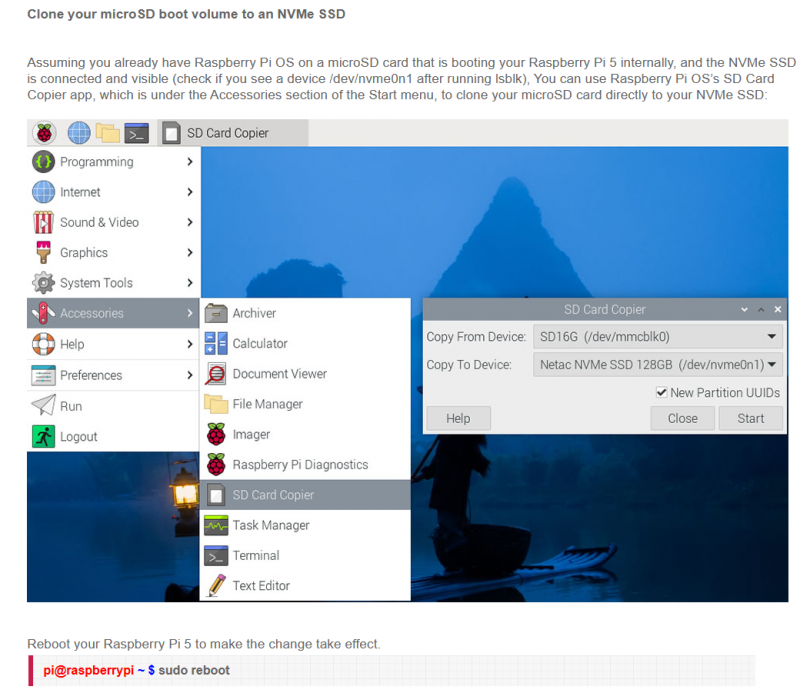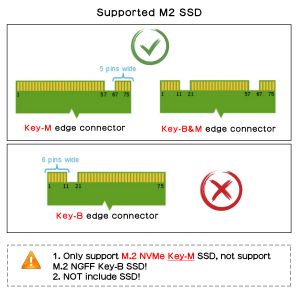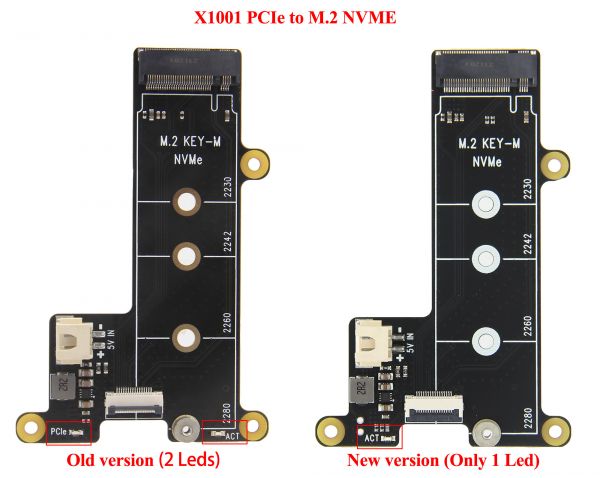Difference between revisions of "NVMe SSD boot with the Raspberry Pi 5"
(→FAQ) |
|||
| (24 intermediate revisions by the same user not shown) | |||
| Line 1: | Line 1: | ||
{{GD Template Impl}} | {{GD Template Impl}} | ||
| − | |||
| − | |||
<!-- | <!-- | ||
==<span class="tb_red">READ ME before Starting</span>== | ==<span class="tb_red">READ ME before Starting</span>== | ||
| Line 19: | Line 17: | ||
'''[PS]''': The official Raspberry Pi firmware is frequently upgraded and the OS is not stable enough. It is also a challenge for us. | '''[PS]''': The official Raspberry Pi firmware is frequently upgraded and the OS is not stable enough. It is also a challenge for us. | ||
--> | --> | ||
| + | |||
| + | This tutorial<ref>Refer to [https://www.jeffgeerling.com/blog/2023/nvme-ssd-boot-raspberry-pi-5 NVM NVMe SSD boot with the Raspberry Pi 5]</ref> describes how to configure the Raspberry Pi OS on PI 5 to get pcie pip working | ||
== Important Notes== | == Important Notes== | ||
| Line 40: | Line 40: | ||
dtparam=pciex1_gen=3 | dtparam=pciex1_gen=3 | ||
| − | <span class=" | + | <span class="tb_red_bold">WARNING:</span><span class="tb_red">The Raspberry Pi 5 is not certified for Gen 3.0 speeds, and connections to PCIe devices at these speeds may be unstable.</span> |
| − | |||
| − | <span class="tb_red">The Raspberry Pi 5 is not certified for Gen 3.0 speeds, and connections to PCIe devices at these speeds may be unstable.</span> | ||
Then DON'T forgot to reboot | Then DON'T forgot to reboot | ||
| Line 49: | Line 47: | ||
You also can refer to official documentatio:[https://www.raspberrypi.com/documentation/computers/raspberry-pi-5.html#enabling-pcie Enabling PCIe] | You also can refer to official documentatio:[https://www.raspberrypi.com/documentation/computers/raspberry-pi-5.html#enabling-pcie Enabling PCIe] | ||
| − | + | After reboot,use the lspci command to display your PCIe devices | |
sudo lspci | sudo lspci | ||
The output is as follows, note that the content of the third line depends on the NVME control you are using. | The output is as follows, note that the content of the third line depends on the NVME control you are using. | ||
| Line 57: | Line 55: | ||
0001:00:00.0 PCI bridge: Broadcom Inc. and subsidiaries Device 2712 (rev 21) | 0001:00:00.0 PCI bridge: Broadcom Inc. and subsidiaries Device 2712 (rev 21) | ||
0001:01:00.0 Ethernet controller: Device 1de4:0001 | 0001:01:00.0 Ethernet controller: Device 1de4:0001 | ||
| − | <span class="tb_red">If your NVMe SSD is not recognized, updating the bootloader firmware is essential!</span> | + | <span class="tb_red">If your NVMe SSD is not recognized, updating the bootloader firmware is essential!</span>Refer to [[How to update eeprom firmware]] to update firmware or [[#FAQ]] Q1 to know more details. |
| − | |||
| − | |||
| − | |||
| − | |||
| − | |||
| − | |||
| − | |||
| − | |||
| − | |||
| − | |||
| − | |||
| − | |||
| − | |||
| − | |||
| − | |||
| − | |||
| − | |||
| − | |||
| − | |||
| − | |||
==Flash OS onto NVME SSD== | ==Flash OS onto NVME SSD== | ||
| Line 123: | Line 101: | ||
The PCIe connection should work after a reboot, but your Pi won't try booting off an NVMe SSD yet. For that, you need to change the '''BOOT_ORDER''' in the Raspberry Pi's bootloader configuration: | The PCIe connection should work after a reboot, but your Pi won't try booting off an NVMe SSD yet. For that, you need to change the '''BOOT_ORDER''' in the Raspberry Pi's bootloader configuration: | ||
| − | Run the following command | + | * Use tool '''raspi-config''' to set boot order |
| + | sudo raspi-config | ||
| + | Then select '''6 Advanced Opitions''' => '''A4 Boot Order''' => '''B2 NVMe/USB Boot''' answer '''Yes''', then <code>sudo reboot</code> | ||
| + | * Run the following command to set boot order. | ||
sudo rpi-eeprom-config --edit | sudo rpi-eeprom-config --edit | ||
Then change the BOOT_ORDER line to the following: | Then change the BOOT_ORDER line to the following: | ||
| Line 142: | Line 123: | ||
BOOT_ORDER=0xf416 | BOOT_ORDER=0xf416 | ||
Then reboot the device with <mark>'''''sudo reboot'''''</mark>, this should drop the power consumption when powered down to around 0.01W. | Then reboot the device with <mark>'''''sudo reboot'''''</mark>, this should drop the power consumption when powered down to around 0.01W. | ||
| − | + | ==References== | |
| + | <references /> | ||
==FAQ== | ==FAQ== | ||
| − | + | {{X100x-FAQ}} | |
| − | |||
| − | |||
| − | |||
| − | |||
| − | |||
| − | |||
| − | |||
| − | |||
| − | |||
| − | |||
| − | |||
| − | |||
| − | |||
| − | |||
| − | |||
| − | |||
| − | |||
| − | |||
| − | |||
| − | |||
| − | |||
| − | |||
| − | |||
| − | |||
| − | |||
| − | |||
| − | |||
| − | |||
| − | |||
| − | |||
| − | |||
Return to [[X1000]] / [[X1001]] / [[X1002]] / [[X1003]] | Return to [[X1000]] / [[X1001]] / [[X1002]] / [[X1003]] | ||
Latest revision as of 14:04, 19 April 2024
This tutorial[1] describes how to configure the Raspberry Pi OS on PI 5 to get pcie pip working
Contents
Important Notes
NVMe SSD Incompatibility List
We recommend avoiding the following NVMe SSD drives which is equipped with a Phison controller due to their proven incompatibility:
- WD Blue SN550 series (Solved! Refer to New rpi-eeprom-update 2024-01-24 WD Blue SN550 nvme works now.)
- WD Green SN580 series
- WD Green SN350 series
- WD Black SN850 series
- WD Black SN770
- Inland tn446 nvme drive
- Corsair MP600 SSD
- Other NVMe SSD drivers equipped with the same Phison controller
These specific models have demonstrated compatibility issues, and it is advisable to avoid them when considering NVMe SSD options for the X10xx series NVMe shield. You can run "lspci" command to check the controller brand of the SSD.
We hope the Raspberry Pi Foundation will resolve this issue soon.
Also note:
- Compatible with M.2 NVMe SSDs only, Not compatible with M.2 SATA SSDs, M.2 PCIe AHCI SSDs, or other M.2 non-NVMe devices
- Older NVMe drives with less efficient flash media may not perform as well as newer drives
- New NVMe SSDs are not partitioned and will need to be both partitioned and formatted when first connected to the Raspberry Pi before they will be accessed in the Explorer.
- We get feedback from customers that Polaris Controller will also have compatibility problems. Please replace the other SSD test if it not work, whether it is compatible with the Raspberry Pi 5 does not depend on the X100X series boards
PS: There is also feedback from buyers that even NVME SSDs with Phison controller are supported after updating the latest firmware. Please refer to go to: X1001#comment-4638
Enable PCIe
By default the PCIe connector is not enabled. To enable it you should add the following option into /boot/firmware/config.txt and reboot:
sudo nano /boot/firmware/config.txt
Then add the following comment;
# Enable the PCIe External connector. dtparam=pciex1 # This line is an alias for above (you can use either/or to enable the port). dtparam=nvme
Press Ctrl-O, then enter, to write the change to the file.
Press Ctrl-X to exit nano (the editor).
And the connection is certified for Gen 2.0 speed (5 GT/sec), but you can force it to Gen 3.0 (10 GT/sec) if you add the following line after:
dtparam=pciex1_gen=3
WARNING:The Raspberry Pi 5 is not certified for Gen 3.0 speeds, and connections to PCIe devices at these speeds may be unstable.
Then DON'T forgot to reboot
sudo reboot
You also can refer to official documentatio:Enabling PCIe
After reboot,use the lspci command to display your PCIe devices
sudo lspci
The output is as follows, note that the content of the third line depends on the NVME control you are using.
pi@raspberrypi: ~ $ sudo lspci 0000:00:00.0 PCI bridge: Broadcom Inc. and subsidiaries Device 2712 (rev 21) 0000:01:00.0 Non-Volatile memory controller: Silicon Motion, Inc. SM2263EN/SM2263XT SSD Controller (rev 03) 0001:00:00.0 PCI bridge: Broadcom Inc. and subsidiaries Device 2712 (rev 21) 0001:01:00.0 Ethernet controller: Device 1de4:0001
If your NVMe SSD is not recognized, updating the bootloader firmware is essential!Refer to How to update eeprom firmware to update firmware or #FAQ Q1 to know more details.
Flash OS onto NVME SSD
To get the NVMe SSD to boot your Pi, it needs to have an OS, so the Raspberry Pi OS needs to be flashed onto NVME SSDs, this is very important!
Only support Raspberry Pi OS (Bookworm) version, Raspberry Pi OS bullseye or Ubuntu or Home Assistant OS is NOT supported, refer to https://www.raspberrypi.com/software/operating-systems/
Here are a few ways to flash the OS to an NVME SSD:
1. Use SD Card Copier tool to flash OS onto the NVME SSD On Raspberry Pi OS(recommended)
- This method works if you have an SD card and have booted the device successfully
Cick Applications =>Accessories =>SD Card Copier on the main screen, run the SD Card Copier program, and copy the OS to the NVME ssd as shown in the figure below.
Click Start to run. Then shut down, unplug the SD card, and restart the device.
This is a visual operation and we highly recommend it!
2. Flash the SSD with Raspberry Pi Imager
You can also directly use the Raspberry Pi Imager tool on a MAC computer or windows computer to flash a fresh Pi OS to NVME SSD, but you will need an additional USB to nvme adapter.
- Install Pi Imager and open it
- Plug your NVMe SSD into your computer using a USB to NVMe adapter
- Choose an OS to install
- Choose the drive (connected through your adapter) to flash
- Click write (and set any options you'd like)
- Once you have finished flashing the OS, DON'T remove the nvme SSD. You need to change the config.txt in the root directory of the NVME SSD drive to enable pcie (edit config.txt and add 'dtparam=pciex1' on the end of file), this is very important and too many people forget this.
Then pull the NVMe drive, attach it to your Pi 5, and it should boot off it (with or without a microSD card inserted)—assuming you have the bootloader up to date and set the BOOT_ORDER appropriately!
NOTE:
If you are flashing a fresh Pi OS to NVME ssd, you must #Enable PCIe; if you are COPY or CLONE an old Pi OS from SD card to NVME ssd, and you have already enabled pcie in the old Pi OS in advance, then you don't need to do enable pcie again!
Set NVMe early in the boot order
The PCIe connection should work after a reboot, but your Pi won't try booting off an NVMe SSD yet. For that, you need to change the BOOT_ORDER in the Raspberry Pi's bootloader configuration:
- Use tool raspi-config to set boot order
sudo raspi-config
Then select 6 Advanced Opitions => A4 Boot Order => B2 NVMe/USB Boot answer Yes, then sudo reboot
- Run the following command to set boot order.
sudo rpi-eeprom-config --edit
Then change the BOOT_ORDER line to the following:
BOOT_ORDER=0xf416
- Press Ctrl-O, then enter, to write the change to the file.
- Press Ctrl-X to exit nano (the editor).
Read Raspberry Pi's documentation on BOOT_ORDER for all the details. For now, the pertinent bit is the 6 at the end: that is what tells the Pi to attempt NVMe boot first!
Reboot your Raspberry Pi 5 to make the change take effect.
Decrease wattage when turned off
By default, the Raspberry Pi 5 consumes around 1W to 1.4W of power when turned off. This can be decreased by manually editing the EEPROM configuration with sudo rpi-eeprom-config -e. Change the settings to the following:
BOOT_UART=1 POWER_OFF_ON_HALT=1 BOOT_ORDER=0xf416
Then reboot the device with sudo reboot, this should drop the power consumption when powered down to around 0.01W.
References
FAQ
Q1: Can't boot/recognize from NVMe SSD?
A: Here are a few steps to help you troubleshoot some issues:
- Only Raspberry Pi OS (Bookworm) supports PCIe, Raspberry Pi OS bullseye is NOT supported, refer to https://www.raspberrypi.com/software/operating-systems/
- Make sure that your OS configuration (
/boot/firmware/config.txt) is completely correct: refer to the tutorial:NVMe SSD boot with the Raspberry Pi 5 (will Continuously updating) - Update the bootloader firmware to the last verson, refer to How to update eeprom firmware, this is very important!!! Make sure your upgrade is successful by running command vcgencmd bootloader_version
- Add PCIE_PROBE=1 to the eeprom, (Run sudo rpi-eeprom-config --edit command, then add this line, then press CTRL+O to write change to file, press CTRL+X to exit, then reboot)
- Make sure the SSD type you use is correct, only support M.2 NVME (Sata) Key-M SSD NOT support M.2 NGFF Key-B SSD. Refer to the right diagram:
- Make sure the FPC cable is firmly and fully inserted into the PI 5, this is very important. For X1003 shield, make sure the FPC cable direction is correct also.
- For X1003 shield, make sure the FPC cable direction is correct also. If an error still occurs, replace the FFC cable to test or purchase other PFC from here[1]to troubleshoot the issue.
- Read this post to get some help;
- Although you can also boot from a SD card, Pi OS is required for the NVMe SSD to boot, DON'T forget Flash OS into NVMe SSD.
- If you're flashing a fresh Pi OS into NVME SSD , DON'T forget to ENABLE PCIe to NVME SSD.
- Run the lspci andlsblk command to check the NVMe SSD is recognized.
- Start thinking about SSD compatibility issues and try to switch to other brands of NVME SSDs.
- Contact us at email: support@geekworm.com, and attached your product model, OS version (run uname -a to get), bootloader version (run vcgencmd bootloader_version to get) and order number
- How to get FPC Wires:
- ↑
Amazon US: https://www.amazon.com/dp/B0CXCTPQ2N
Amazon DE: https://www.amazon.de/dp/B0CX4T993J
Amazon UK: https://www.amazon.co.uk/dp/B0CX4T993J
Amazon JP: https://www.amazon.co.jp/dp/B0CYGKN7G1
- PS: The shortest length of the FPC cable here is 30mm, but the length of the FPC cable used by X1003 is only 22mm. For X1003, this may not be perfect, but you can use these FPC cables to troubleshoot the issue. DON'T buy it if you mind.
Q2: Don't recognize / boot from NVME SSD?
A: If you have enabled pcie and find that you still cannot boot from NVME SSD, please perform the following actions
1. Follow the picture below to check the version of X1001 or X1000
2. If it is an Old Version, refer to How to update eeprom firmware to update the firmware with pieeprom-2023-10-30.bin file.
3. If it is an New Version, refer to How to update eeprom firmware to update the firmware to lasted version.
4. If you still have not solved the problem, please refer to the next FAQ:Q1
Q3: How to fix the 2230/2242/2260 SSD on X1001 or other PIP?
A: The X1001 and other pips does not reserve the nut column to fix the 2230/2242/2260 SSD. Based on our test, you can secure the 2230/2242/2260 SSD using an M2*6mm screw and 2pcs M2 nuts. Place one M2 nut under the SSD, then use the M2*6mm screw and the other M2 nut to fasten the SSD.
PS: As of April 2024, we have added customized copper pillar in only X1001 packing list to solve this issue, please refer to the packing list of X1001.
Q4. X1002 can't boot when install into the P580 case?
A: Please check if the FPC cable touch the metal case make shorting when install X1002 into the metal case, you can stick the electrical tape on the case to prevent the ribbon FPC cable from contacting the case to test.
Q5: Which NVMe drives work with a Raspberry Pi 5?
A: You can refer to the video: https://youtu.be/3mUgVTBmKio.



Enable comment auto-refresher
Anonymous user #11
Permalink |
Anonymous user #8
Permalink |
Anonymous user #6
Permalink |
Anonymous user #9
Anonymous user #10
Anonymous user #5
Permalink |
Anonymous user #7
Anonymous user #4
Permalink |
Anonymous user #4
Anonymous user #3
Permalink |
Anonymous user #2
Permalink |
Harry
Anonymous user #1
Permalink |
Walker